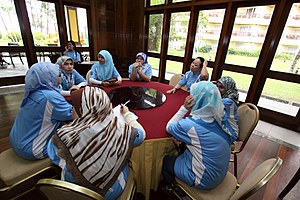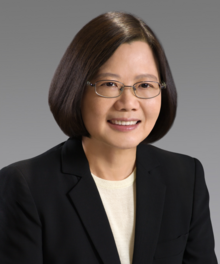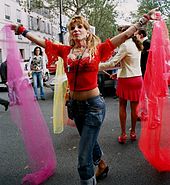By country, women of Asia come from sovereign states such those women from Armenia, Iraq, Israel, Japan, Vietnam, and Yemen.
Other Asian women come from states with limited international recognition such as women from Abkhazia, Nagorno-Karabakh, Northern Cyprus, Palestine, South Ossetia, and Taiwan.
Other women from Asia come from dependent territories such as women from the British Indian Ocean Territory, Christmas Island, the Cocos (Keeling) Islands, Hong Kong, and Macau.
Other Asian women come from states with limited international recognition such as women from Abkhazia, Nagorno-Karabakh, Northern Cyprus, Palestine, South Ossetia, and Taiwan.
Other women from Asia come from dependent territories such as women from the British Indian Ocean Territory, Christmas Island, the Cocos (Keeling) Islands, Hong Kong, and Macau.
Culture
An Azeri young woman from Baku, in 1897
Traditional roles
Due to the patriarchal nature of traditional Armenian culture and society, women in Armenia are often expected to be virtuous and submissive, to safeguard their virginity until marriage, and assume primarily domestic tasks.
Traditional social norms and lagging economic development in Azerbaijan's rural
regions continue to restrict women’s roles in society and the economy,
and there were reports that women had difficulty exercising their legal
rights due to gender discrimination.
Women in Cambodia, sometimes referred to as Khmer women, are supposed to be modest, soft-spoken, "light" walkers, well-mannered, industrious, belong to the household, act as the family's caregivers and caretakers and financial comptrollers, perform as the "preserver of the home", maintain their virginity until marriage, become faithful wives, and act as advisors and servants to their husbands.
The "light" walking and refinement of Cambodian women is further
described as being "quiet in […] movements that one cannot hear the
sound of their silk skirt rustling".
Throughout the history of Persia, Persian women (presently known as women in Iran),
like Persian men, used make-up, wore jewellery and coloured their body
parts. Moreover, their garments were both elaborate and colorful. Rather
than being marked by gender, clothing styles were distinguished by
class and status. Women in modern Iran (post 1935 "Persia") are of various mixes and appearances, both in fashion and social norm.
Traditionally however, the "Persian woman" had a pre-defined appearance
set by social norms that were the standard for all women in society.
Women in Kyrgyzstan traditionally had assigned roles, although only the religious elite sequestered women as was done in other Muslim societies.
Historically, women in Burma (Myanmar) have had a unique social status in Burmese society. According to the research made by Daw Mya Sein, Burmese women
"for centuries – even before recorded history" owned a "high measure of
independence" and had retained their "legal and economic rights"
despite the influences of Buddhism and Hinduism. Burma once had a matriarchal system that includes the exclusive right to inherit oil wells and the right to inherit the position as village head. Burmese women were also appointed to high offices by Burmese kings, can become chieftainesses and queens.
Palestinian women were not expected to secure income for the
family, but women were expected to adapt to the customary roles of women
in Palestinian society wherein females were traditionally molded as
inferior to men.
The role of women in Turkmenistan has never conformed to Western stereotypes about Muslim women.
Although a division of labor exists and women usually are not visible
actors in political affairs outside the home, Turkmen women have never worn a veil similar to that of the women of some of its neighboring countries.
As Turkmenistan is a tribal nation, customs regarding women can vary
within the country: for example, women in the eastern part of the
country are permitted to drink some alcohol whereas women who live in
the central portion of the country, particularly those of the Tekke
tribe, are not permitted to imbibe alcohol. Most women possess a host
of highly specialized skills and crafts, especially those connected with
the household and its maintenance.
Promoting gender equality
Two young women in Kazakhstan
Women in Azerbaijan nominally enjoy the same legal rights as men; however, societal discrimination is a problem. Universal suffrage was introduced in Azerbaijan in 1918 by the Azerbaijan Democratic Republic, thus making Azerbaijan the first Muslim country ever to enfranchise women. Most Bahraini
women are also well represented in all of the major professions,
women’s societies, and women’s organizations. Apart from having the
right to vote, around one-quarter of the women of Bahrain are able to
hold jobs outside the confines of the household.
Available data on health, nutrition, education, and economic
performance indicated that in the 2014 women participation in the
workforce was 57%. Bangladesh has a gender development index of .917.
As financial controllers, the women of Cambodia can be identified as having real household authority at the familial level. In recent years, women have become more active in the traditionally male-dominated spheres of work and politics in Cambodia.
October 1, 1949 marks the formal establishment of the People's Republic of China. Since 1949, the government of the People's Republic of China
has actively promoted the cultural, social, economic and political
roles of women in order to improve women's liberation. The new
government of the People's Republic made a commitment to achieve
equality between women and men. While advancing towards equality among men and women, the efforts met resistance in a traditionally Confucian society of male superiority.
Although equality among men and women has been a long-term goal
of the People's Republic of China, the dramatic reformations that
followed the Cultural Revolution (1966–1976) have inconsistently affected women's empowerment and status in China. Studies shows that Chinese women experienced rapid progress in terms of gender equality during the Cultural Revolution.
When the People's Republic of China was established, employed women
accounted for only 7 percent of the workforce; whereas in 1992 women's
participation in the workforce had increased to account for 38 percent.
Women's representation in higher educational institutions has also
increased since the establishment of the People's Republic of China. Under the traditional Chinese patriarchy structure, the society was male-dominated, and women in Hong Kong had a relatively subordinate familial role. However, there is a cultural change in Hong Kong during the British colonial period with an emergence of Western culture (i.e. "Westernization"). A mix of traditional Chinese culture and Western values creates a unique culture of Hong Kong. Along with the rapid economic and social development of Hong Kong since the end of the Second World War,
a significant improvement in the role of men has been witnessed, while
female dominance society structure is still taking in place. Hence, women studies in Hong Kong are slightly differ from China's.
Women in Hong Kong are generally more independent, monetarily
autonomous, assertive, and career-focused; which makes them seem to be
more prominent when comparing with women in some other Southeast Asian countries.
With the increase number of women in professional and managerial
positions in recent decades, the terms of "female strong person" or "superwomen" are being used to describe women in Hong Kong. Candice Chio Ngan Ieng, president of the Macau Women's General Association (AGMM), describes in 2010 that women are currently defining themselves as capable and irreplaceable powers to Macau's modern-day civilization. This change is happening despite the slowness in the Macanese people's absorption of the ideological concept of gender equality.
The status of women in India has been subject to many great changes over the past few millennia. From equal status with men in ancient times through the low points of the medieval period, to the promotion of equal rights by many reformers, the history of women in India has been eventful.
The roles of Indonesian women today are being affected by many factors, including increased modernization, globalization, improved education and advances in technology (in particular communications
technology). Many women in Indonesia choose to reside in cities instead
of staying in townships to perform agricultural work because of
personal, professional, and family-related necessities, and economic
requirements. These women are moving away from the traditional dictates
of Indonesian culture,
wherein women act simply and solely as wives and mothers. At present,
the women of Indonesia are also venturing actively into the realm of
national development, and working as active members of organizations that focus and act on women's issues and concerns.
The Iranian women's movement is based on the Iranian women's social movement for women's rights. This movement first emerged some time after the Iranian Constitutional Revolution
in 1910, the year in which the first Women Journal was published by
women. The movement lasted until 1933 in which the last women’s
association was dissolved by the Reza Shah Pahlavi’s government. It heightened again after the Iranian Revolution (1979).
Between 1962 and 1978, the Iranian women's movement gained tremendous
victories: women won the right to vote in 1963 as part of Mohammad Reza
Shah's White Revolution,
and were allowed to stand for public office, and in 1975 the Family
Protection Law provided new rights for women, including expanded divorce
and custody rights and reduced polygamy.
Following the 1979 Revolution, several laws based on gender
discrimination were established such as the introduction of mandatory
veiling and public dress code of females. Women's rights since the Islamic Revolution has varied. About 9% of the Iranian parliament members are women, while the global average is 13%. Following the Revolution, women were allowed to join the police and military forces.
The women's rights movement in Iran continues to attempt influencing reforms, particularly with the One Million Signatures Campaign to End Discrimination Against Women.
Women in the country went through a difficult period in the
1990s, when Kazakhstan's economy, being in a period of transition,
experienced a strong decline and destabilization: by 1995 real GDP
dropped to 61,4% of its 1990 level, resulting also in a brain drain. Nevertheless, the 1990s also had some positives for women, such as the accession to the Convention on the Elimination of All Forms of Discrimination Against Women in 1998.
Women in Kuwait are considered to be among the most emancipated women in the Gulf region.
Women in Kuwait can travel, drive, and work without their fathers' or
husbands' consent and they even hold senior government positions. Women in Kuwait are able to work freely and can achieve positions of power and influence.
Women in Kuwait gained the right to vote and stand in parliamentary and local elections in May 2005.
And in October 2009 Kuwait's constitutional court ruled that women were
able to gain their own passports, without the consent of their
husbands.
Because of the demands of the nomadic
economy, women in Kyrgyzstan worked as virtual equals with men, having
responsibility for chores such as milking as well as child-rearing and
the preparation and storage of food. In the ordinary family, women enjoyed approximately equal status with their husbands, within their traditional roles.
Laotian women have long been active participants in their nation's
society, involved in politics, driving social transformation and
development, becoming active in the world of business and serving as nurses and food producers for the military. Due to modernization and rural uprooting, Lao women have begun to embrace lifestyles that are foreign to traditional Laotian ideals.
Due to the large number of officially recognized religions in Lebanon, Lebanese family matters are governed by at least 15 personal statute codes. Lebanese women have legal protection that varies depending on their religion.
Marriageable age can be as young as 12.5, polygamy is allowed if the
male of the family is Muslim, parental authority belongs to the
patriarch of the house and legal guardian of all children, and female
children receive less inheritance than a male child would. Children born to a Lebanese woman and a man from another country will not have their children granted Lebanese nationality.
Malaysian women sit at a restaurant, 2009.
Women in Malaysia receives support from the Malaysian government
concerning their rights to advance, to make decisions, to health,
education and social welfare, and to the removal of legal obstacles. The
Malaysian government has ensured these factors through the
establishment of Ministry of National Unity and Social Development in
1997 (formerly known in 1993 as Women's Affairs Secretariat or HAWA).
This was followed by the formation of the Women's Affairs Ministry in
2001 to recognize the roles and contributions of Malaysian women. Around
47% of Malaysian women are in the workforce.
Women now pursue careers and professional training in Oman,
slowly moving from their previous household confinement to the public
sphere. In Oman, 17 October is celebrated every year as the Omani Women's Day with various pro-female events.
The Pakistani women of today enjoy a better status than most
Muslim women. However, on an average, the women's situation vis-à-vis
men is one of systemic gender subordination, although there have been attempts by the government and enlightened groups to elevate the status of women in Pakistani society.
Now due to lots of awareness among people the educational opportunities
for the Pakistani women increased in the previous years. According to a Human Development Report released by the United Nations, Pakistan has better gender equality than neighboring India. However, in 2012, the World Economic Forum ranked Chad, Pakistan and Yemen as the worst in their Global Gender Gap Report.
Although they generally define themselves in the milieu of a masculine dominated post-colonial Asian Catholic society, Filipino
women live in a culture that is focused on the community, with the
family as the main unit of society. It is in this framework of Philippine
hierarchical structure, class differences, religious justifications,
and living in a globally developing nation that Filipino women struggle
for respect. Compared to other parts of Southeast Asia, women in Philippine society have always enjoyed a greater share of legal equality.
All women, regardless of age, are required to have a male
guardian in Saudi Arabia. Saudi Arabia is the only country in the world
that prohibits women from driving. The World Economic Forum 2009 Global Gender Gap Report
ranked Saudi Arabia 130th out of 134 countries for gender parity. It
was the only country to score a zero in the category of political
empowerment. The report also noted that Saudi Arabia is one of the few
Middle Eastern countries to improve from 2008, with small gains in
economic opportunity.
21% of Saudi women are in the workforce and make up 16.5% of the overall workforce.
There is evidence that some women in Saudi Arabia do not want
change. Even many advocates of reform reject Western critics, for
"failing to understand the uniqueness of Saudi society."
Journalist Maha Akeel
is a frequent critic of her country's patriarchal customs. Nonetheless,
she agrees that Westerners criticize what they do not understand. She
has said: "Look, we are not asking for ... women's rights according to
Western values or lifestyles ... We want things according to what Islam
says. Look at our history, our role models."
Women in Singapore, particularly those who have joined Singapore's
workforce, are faced with balancing their traditional and modern-day
roles in Singaporean society and economy. According to the book The Three Paradoxes: Working Women in Singapore written by Jean Lee S.K., Kathleen Campbell, and Audrey Chia, there are "three paradoxes" confronting and challenging the career women
of Singapore. Firstly, Singapore's society expects women to become
creative and prolific corporate workers who are also expected to play
the role of traditional women in the household, particularly as wife and
mother. Secondly, Singaporean women are confronted by the "conflict
between work and family" resulting from their becoming members of the
working population. Thirdly, Singapore's female managers are still
fewer in number despite of their rising educational level and
attainments when compared to male managers.
Syria Comment described that Syrian women have been able to acquire several rights that have not been granted to their counterparts in other Arab nations. Such rights include the custody of children aged 15 years old or younger; and the right to give their nationality to their offspring whose father is not a national of Syria. A common attire of women, particularly in Damascus, are Western clothing that includes long skirts, pants, jeans, high-heeled shoes, in addition to the sporting of the hijab and the monteau (a type of coat), sometimes accented by a “coordinating purse”.
The role of women in the United Arab Emirates has advanced greatly in recent years, making the UAE a leader in women's rights in the Arab world.
Though there were few opportunities for women outside the home before
1960, the discovery of oil led to advancement in women's position. The
UAE constitution guarantees equality between men and women in areas
including legal status, claiming of titles, and access to education. The
General Women's Union (GWU), established by HH Sheikha Fatima bint
Mubarak wife of then President Sheikh Zayed bin Sultan Al Nahyan,
remains a strong component of the State's and participating
organizations' various initiatives. In the 2007/2008 United Nations
Development Programme report, the UAE ranked 29th among 177 countries in
the Gender Empowerment Measures, the best rating received in the Arab
World. UNDP’s Millennium Development Goal
No. 3, to “Promote Gender Equality and Empower Women” has reached its
targeted levels of female participation in primary education and
continues to increase.
Women in Yemen have historically had much less power in
society than men. Although the government of Yemen has made efforts that
will improve the rights of women in Yemen (including the formation of a
Women's Development Strategy and a Women Health Development Strategy),
many cultural and religious norms, along with poor enforcement of this
legislation from the Yemeni government, have prevented Yemeni women from
having equal rights to men.
Today, Yemeni women do not hold many economic, social or cultural rights. Even more striking is the reality that while suffrage was gained in 1967 and constitutional and legal protection was extended to women during the first years of Yemen unity between 1990–1994, they continue to struggle “in exercising their full political and civil rights”.
History shows that women have played major roles in Yemeni society.
Some women of pre-Islamic and early Islamic Yemen held elite status in
society. The Queen of Sheba, for example, “is a source of pride for the
Yemeni nation”.
In addition, Queen Arwa has been noted for her attention to
infrastructure, which added to a documented time of prosperity under her
rule.
Modern day women of Yemen, however, are subject to a society that
reflects largely agrarian, tribal, and patriarchal traditions. This,
combined with illiteracy and economic issues has led women to
continuously be deprived of their rights as citizens of Yemen.
The roles of women in Thailand's national development has not yet
been fully established. Factors that affect women's participation in
the socio-economic field include "inadequate gender awareness in the
policy and planning process" and social stereotyping.
During the Soviet
period, women in Turkmenistan assumed responsibility for the observance
of some Muslim rites to protect their husbands' careers.
Many women entered the work force out of economic necessity, a factor
that disrupted some traditional family practices and increased the
incidence of divorce. At the same time, educated urban women entered professional services and careers. The social and legal situation of women in Uzbekistan has been influenced by local traditions, religion, the Soviet rule, and changing social norms since independence.
Women in Vietnam played a significant role in defending Vietnam during the Vietnam War
from 1945 to 1975. They took roles such as village patrol guards,
intelligence agents, propagandists, and military recruiters. By
becoming "active participants" in the struggle to liberate their country
from foreign occupation, Vietnamese women were able to free themselves
from "centuries of Confucian influence that had made them second-class citizens". Historically, this character and spirit of Vietnamese women were first exemplified by the conduct of the Trung sisters, the “first historical figures” in the history of Vietnam who revolted against Chinese control. This trait is also epitomized in the old Vietnamese adage: "When war comes, even women have to fight", and its variation: "When the enemy is at the gate, the woman goes out fighting".
Bangladeshi women peacekeepers at MONUSCO, Kinshasa
Women in government
As
of 2007, several women in Azerbaijan held senior government positions,
including deputy speaker of parliament, several deputy ministers, and
deputy chair of the Central Election Commission. There are no legal restrictions on the participation of women in politics. As of 2011, there were 19 women in the 125-seat parliament. The percentage of female members of parliament increased from 11 to 16 percent between 2005 and 2010.
Bangladesh as of 2015 has a female speaker of parliament and Prime Minister. In modern India, women have held high offices in India including that of the President, Prime Minister, Speaker of the Lok Sabha and Leader of the Opposition. As of 2011, the Speaker of the Lok Sabha and the Leader of the Opposition in the Lok Sabha (Lower House of the parliament) were women.
Tsai Ing-wen, elected as president of Taiwan in 2016. She is the first Asian female elected as either head of state or head of government without political family background.
Women cannot vote or be elected to high political positions in Saudi Arabia. However, King Abdullah has declared that women will be able to vote and run in the 2015 local elections, and be appointed to the Consultative Assembly.
Women in Taiwan have especially achieved prominent roles in politics. In 2000, feminist movement advocator Annette Lu elected as first female vice president while Yeh Chu-lan was promoted to be the first female vice premier in 2004. In 2016, Tsai Ing-wen was elected as president of Taiwan. Nevertheless, as in other parts of East Asia, sex selective abortion is reported to happen in Taiwan.
Women in Thailand were among the first women in Asia who were granted the right to vote in 1932. However, they are still underrepresented in Thai politics.
Violence and sexual harassment against women
Violence
against women in Afghanistan is high, although the situation is
improving slowly as the country progresses with the help of the
international community.
Bride kidnapping occurs in Azerbaijan.
In the Azeri kidnap custom, a young woman is taken to the home of the
abductor's parents through either deceit or force. Regardless of whether
rape occurs or not, the woman is generally regarded as impure by her
relatives, and is therefore forced to marry her abductor.
Women in India continue to face atrocities such as rape, acid
throwing, dowry killings while young girls are forced into prostitution;
as of late rape has seen a sharp increase following several
high-profile cases of young girls brutally raped in public areas. According to a global poll conducted by Thomson Reuters, India is the "fourth most dangerous country" in the world for women, and the worst country for women among the G20 countries.
Societal discrimination and domestic violence against women has
been identified as a significant problem, particularly in the Israeli Bedouin society.
In the 21st century, the issue of violence against women in Kazakhstan has come to public attention, resulting in the Law on the Prevention of Domestic Violence of 2009. However, as in other parts of Central Asia, bride kidnapping remains a problem.
Local and regional NGOs have helped to increase awareness of violence against women in Lebanon. Government policies regarding this are poor however, and attempts to improve this area have been met with resistance. Lebanon's laws do not recognize the concept of spousal rape, and attempt to add this to law have been attacked by Lebanese clerics.
Pakistani women face atrocities like rape, acid throwing, honour
killings, forced marriages, forced prostitution and the buying and
selling of women. The past few years have been witness to a steep increase in such crimes.
Forced sterilization
Although
Uzbek law provides some safeguards for the security of women in the
country, women continue to face numerous problems, especially violence.
There are reports that forced sterilization of women is practiced in Uzbekistan. A BBC World Service
"Assignment" report on 12 April 2012 uncovered evidence that women are
being sterilized, often without their knowledge, in an effort by the
government to control the population.
Sex-selective abortion and female infanticide
Armenia is one of the countries in Asia which faces the issue of sex-selective abortion. Reports of female infanticide following the execution of the One-child policy indicated the persistence of women's low status in China.
Notable women in Asia
Notable women from Asia include Qiu Jin (China), Trieu Thi Trinh (Vietnam), Miriam Defensor-Santiago (the Philippines), Sirimavo Bandaranaike (Sri Lanka) and
Mandukhai Khatun (Mongolia).
Kyrgyz oral literature includes the story of Janyl-myrza, a young woman who led her tribe to liberation from the enemy when no man in the tribe could do so. In the nineteenth century, the wife of Khan Almyn-bek led a group of Kyrgyz tribes at the time of the Russian conquest of Quqon.










